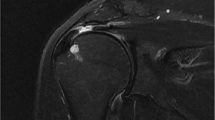Abstract
A Beath pin is drilled on the greater tuberosity under arthroscopy using an anterior cruciate ligament guide. The suture anchor is inserted in the lateral aspect of the footprint. Sutures are then passed through the margins of the rotator cuff tear and tied with sliding knot. One strand of tied suture anchor is passed into the bony trough. One passed strand and the other strand are then tied with a non-sliding knot on the greater tuberosity. The strength of cuff fixation does not only rely on the quality of the bone, it restores the footprint contact area of rotator cuff, and reduces the use of suture anchors to the minimum in this method.







Similar content being viewed by others
References
Apreleva M, Ozbaydar M, Fitzgibbons PG, Warner JJP (2001) Rotator cuff tears: the effect of the reconstruction method on three-dimensional repair site area. Arthroscopy 18:519–526
Fealy S, Kingham TP, Altchek DW (2002) Mini-open rotator cuff repair using a two-row fixation technique: outcomes analysis in patients with small, moderate, and large rotator cuff tears. Arthroscopy 18:665–670
Lo IK, Burkhart SS (2003) Double-row arthroscopic rotator cuff repair: re-establishing the footprint of the rotator cuff. Arthroscopy 19:1035–1042
Burkhart SS, Wirth MA, Simonich M, Salem D, Lanctot D, Athanasiou K (1998) Loop security as a determinant of tissue fixation security. Arthroscopy 14:773–776
Burkhart SS, Wirth MA, Simonich M, Salem D, Lanctot D, Athanasiou K (2000) Knot security in simple sliding knots and its relationship to rotator cuff repair: how secure must the knot be? Arthroscopy 16:202–207
Barber FA, Herbert MA, Richards DP (2003) Sutures and suture anchors: update 2003. Arthroscopy 19(9):985–990
Zuckerman JD, Matsen FA III (1984) Complications about the glenohumeral joint related to the use of screws and staples. J Bone Joint Surg Am 66:175–180
Kaar TK, Schenck RC Jr, Wirth MA, Rockwood CA Jr (2001) Complications of metallic suture anchors in shoulder surgery: a report of 8 cases. Arthroscopy 17(1):31–37
Author information
Authors and Affiliations
Corresponding author
Rights and permissions
About this article
Cite this article
Kim, KC., Rhee, KJ., Shin, HD. et al. Arthroscopic hybrid double-row rotator cuff repair. Knee Surg Sports Traumatol Arthrosc 15, 794–799 (2007). https://doi.org/10.1007/s00167-006-0230-7
Received:
Accepted:
Published:
Issue Date:
DOI: https://doi.org/10.1007/s00167-006-0230-7




